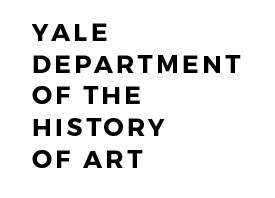Courses
History of Architecture II: The Eighteenth Century to the Millennium
Modern architecture and urbanism from the eighteenth century to the end of the twentieth. Genesis and meaning of architectural form, applying national, cultural, and international contexts.
Independent Tutorial
For students who wish to pursue a subject in the history of art not otherwise covered by departmental offerings. May be used for research or directed reading under faculty supervision. A term paper or its equivalent and regular meetings with the adviser are required. To apply for admission, a student should present a prospectus and a bibliography, signed by the adviser, to the director of undergraduate studies.
Enrollment limited to History of Art majors.
For students who wish to pursue a subject in the history of art not otherwise covered by departmental offerings. May be used for research or directed reading under faculty supervision. A term paper or its equivalent and regular meetings with the adviser are required. To apply for admission, a student should present a prospectus and a bibliography, signed by the adviser, to the director of undergraduate studies.
Enrollment limited to History of Art majors.
Introduction to the History of Art: Buddhist Art and Architecture, 900 to 1600
Buddhist art and architecture of East Asia, Southeast Asia, and Tibet from the tenth century to the early modern period. Emphasis on cross-regional engagements including the impact of Islam.
Introduction to the History of Art: Prehistory to the Renaissance
Form as meaning in architecture, sculpture, and painting. Selected studies in these arts from prehistory to the Renaissance. Source readings in translation.
Introduction to the History of Art: The Arts of Islam
Survey of Islamic art and architecture in the Middle East, North Africa, and South Asia from the seventh century to the present. Individual monuments, artworks, and historical cities examined within their artistic and historical contexts. Architecture and urbanism, manuscript painting and portraiture, and the arts of calligraphy and ceramics. Includes visits to the Yale University Art Gallery.
Introduction to the History of the Art: Global Decorative Arts
Global history of the decorative arts from antiquity to the present. The materials and techniques of ceramics, textiles, metals, furniture, and glass. Consideration of forms, imagery, decoration, and workmanship. Themes linking geography and time, such as trade and exchange, simulation, identity, and symbolic value.
Japanese Screens
The screen-painting tradition in Japan, particularly as it emerged in the sixteenth and seventeenth centuries. The format, techniques, and functions of screen painting; poetic and literary connections, as well as studio practices and politics, of the principal lineages of painters; aesthetics and styles associated with varying classes of patronage, from the shoguns to Buddhist monks to the Japanese court.
Includes site visits in Tokyo and Kyoto during the spring recess.
Landscapes in Southern Asia
From prehistoric cave paintings to recent performance art, landscape has been the site and subject of artistic creation throughout the history of Southern Asia. As sites, landscapes have been carved into monumental complexes and fashioned into sacred geographies and practical cartographies that have been mapped by pilgrimage, commerce, agrarian expansion, and conquest. As subjects, they have been urban and rural places filled with wonder, longing, power, and danger. As imagined spaces, landscapes held the potential to collapse mythic and historic time, to facilitate new encounters, and to cultivate a range of social relations and human emotion responses. This seminar explores the representation and reshaping of landscape in South and Southeast Asia across a range of historical periods and through a variety of media. We experiment with different theoretical frameworks from a variety of fields, both from within art history, as well as within literature, religion, anthropology, and environmental science. As much as possible, we work with Yale’s museum collections, which house a wide diversity of photographs, paintings, drawings, prints, maps, and textiles.
Methods in Art History
An introduction to the foundations of modern art-historical method: formalism, connoisseurship, iconology, social history, visual culture. Readings include Wölfflin, Riegl, Friedländer, Warburg, Kubler, Foucault, Crary, among others.
